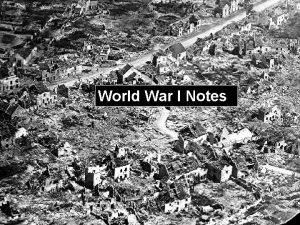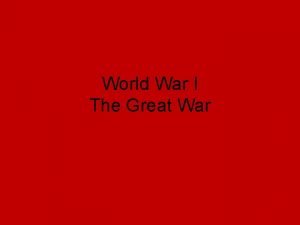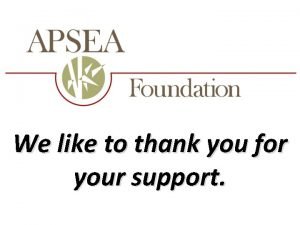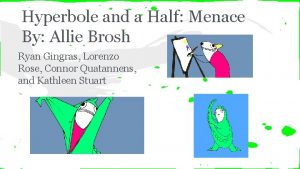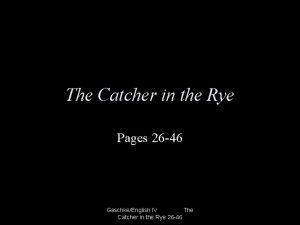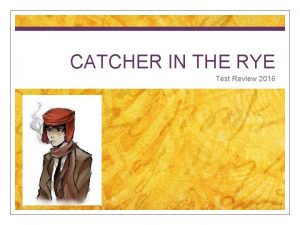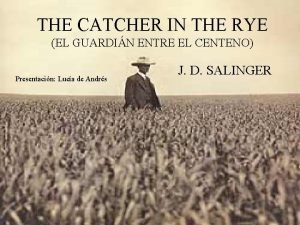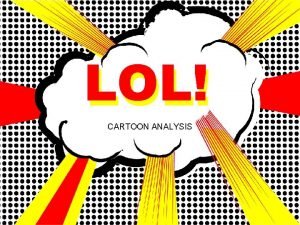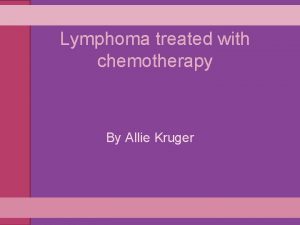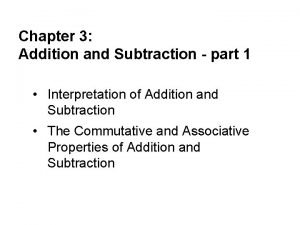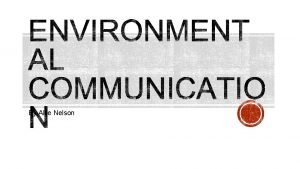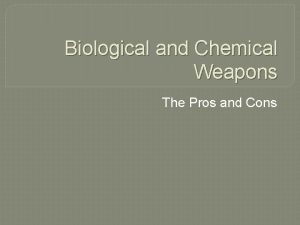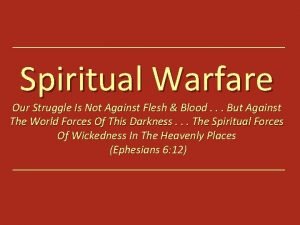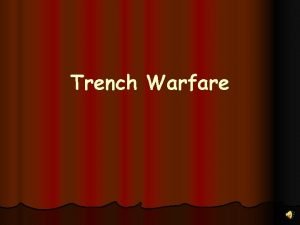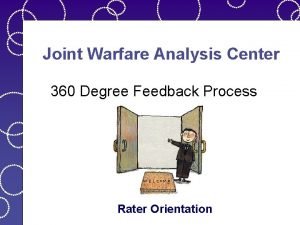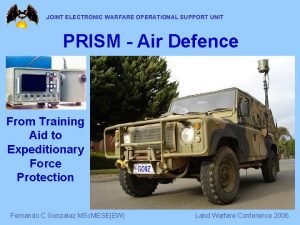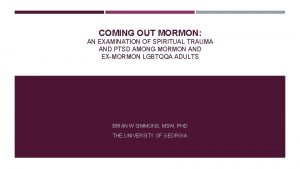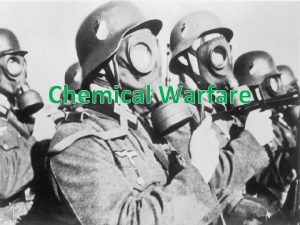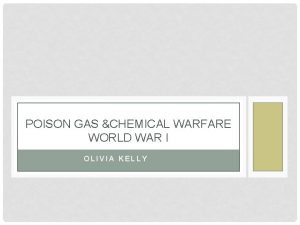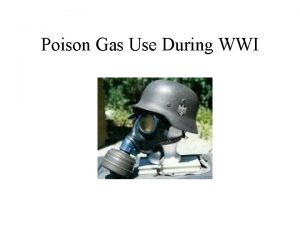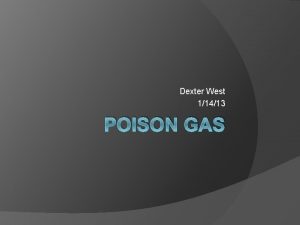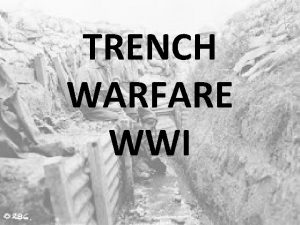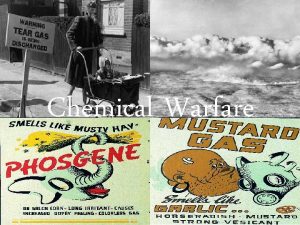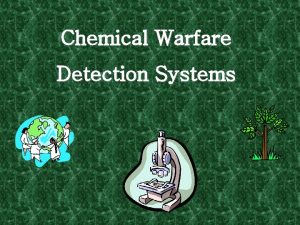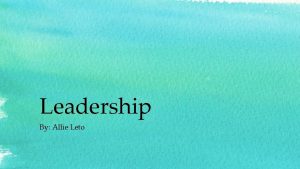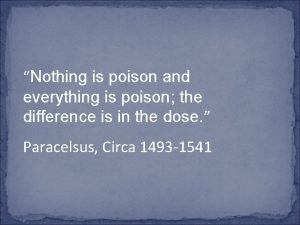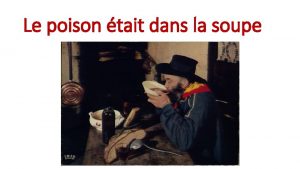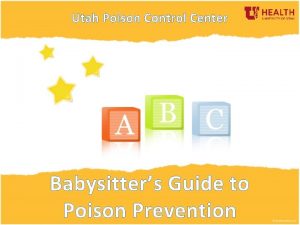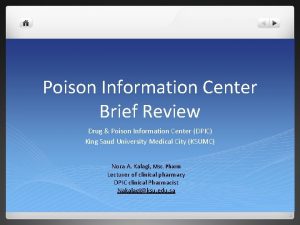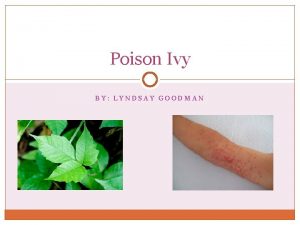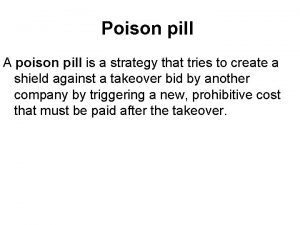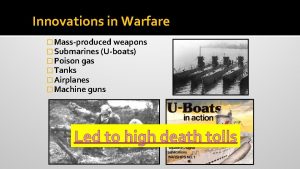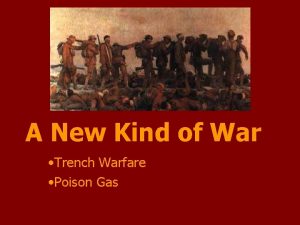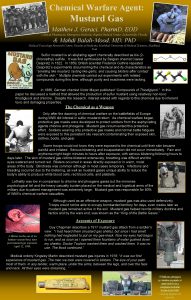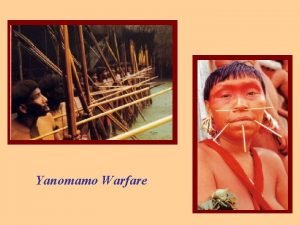Chemical Warfare and Poison Gas Allie Frymire What



















- Slides: 19

Chemical Warfare and Poison Gas Allie Frymire

What is Chemical Warfare/ Poison Gas? � Definition: warfare using the toxic properties of chemical substances as weapons � Definition: poisonous gas or vapor, used especially to disable or kill an enemy in warfare � Chemical warfare and poison gas played a large role in trench warfare � Many types of poison gas were used ◦ Ex. tear gas, chlorine, phosgene & diphosgene, and mustard gas

Tear Gas � Irritates (ethyl bromoacetate, choloracetone, & xylyl bromide) the eyes, mouth, throat, and lungs � Causes crying, coughing, difficulty breathing and temporary blindness � First used in WWI by the French in 1914 � Was used to disarm rather than kill

Chlorine � Has a yellow-green color and smells like bleach � It turns the water in your lungs to hydrochloric acid (p. H <0), causing tissue damage and respiratory failure � A low concentrations, it can cause vomiting, coughing, and eye irritation � First used by the Germans in 1915 in Ypres (caused >1, 100 deaths)

Connection: Chlorine Gas and Dulce et Decorum Est by Wilfred Owen “…GAS! Gas! Quick, boys!-- An ecstasy of fumbling, Fitting the clumsy helmets just in time; But someone still was yelling out and stumbling And floundering like a man in fire or lime. -Dim, through the misty panes and thick green light As under a green sea, I saw him drowning. In all my dreams, before my helpless sight, He plunges at me, guttering, choking, drowning. If in some smothering dreams you too could pace Behind the wagon that we flung him in, And watch the white eyes writhing in his face, His hanging face, like a devil's sick of sin; If you could hear, at every jolt, the blood Come gargling from the froth-corrupted lungs, Obscene as cancer, bitter as the cud…”

Phosgene & Diphosgene (carbonyl dichloride & trichloromethane chloroformate) � Phosgene: colorless gas with a musty odor Diphosgene: colorless oily liquid � Causes suffocation, coughing, fluid buildup in the lungs, and irritation to the throat and eyes � Effects can be delayed up to 24 hours � Caused 85% of gas related deaths

Mustard Gas (bis(2 -chloroethyl) sulfide) � Used in its impure form with a yellow-brown color and garlic-y odor � Burns the eyes, skin, and respiratory system on contact, causes blisters and cell death � First used in 1917 by Germany in Ypres � The mortality rate was only 2 -3%, but victims were left handicapped and required intense and complicated care

Psychological Effects � The fear of gas was just as widespread as gas itself � Many soldiers claimed to be gassed when they simply had a sore throat � If one person said they were gassed, fear of a future gas attack spread like wildfire � “In a war of attrition, morale is critical, and this was an attempt to undermine morale, ” says historian Edgar Jones

Overall Use and Ban � Germany used poison gases the most, but first used by the French (tear gas) � Chemical warfare was looked down upon � The British were the first among the Allied Forces to utilize chemical warfare � Total casualties caused by gas: approx. 1, 240, 853 � The Geneva Protocol, signed in 1925, banned chemical warfare

Review: Flyswatter Game �Rules: the room is divided into two teams, and each turn one student from each team will face off. Swat the fly that corresponds to the correct answer after I finish reading the question. If neither student gets the question right, no points will be given.

Which of the main poison gases caused the most deaths in WWI? Chlorine Mustard Gas Phosgene & Diphosgene Tear Gas

Which country used toxic gases the most throughout WWI? Germany Great Britain France America

Which country was the first to use toxic gases in WWI? Germany Great Britain France America

What was the name of the law that banned chemical warfare? General Protocol Geneva Disarmament General Ban of Toxins Geneva Protocol

In what year was the Geneva Protocol signed? 1925 1992 1918 1921

Which of these gases causes burns and blisters on the skin, eyes, and lungs? Mustard Gas Phosgene Oxygen Chlorine

Poison gas was a very strong _____ weapon because it lowered soldiers’ morale chemical military psychological gaseous

Poison gas and chemical warfare were important in ____ warfare? hole chemical trench Allied

THE END
 Mania militarism
Mania militarism Zimmerman telegram
Zimmerman telegram Allie umemoto
Allie umemoto Allie dunn forum
Allie dunn forum Hyperbole and a half dinosaur
Hyperbole and a half dinosaur Jane gallagher catcher in the rye
Jane gallagher catcher in the rye What does allie's baseball glove symbolize
What does allie's baseball glove symbolize Allie caulfield description
Allie caulfield description Eric allie cartoonist
Eric allie cartoonist Ostiguy c. allie
Ostiguy c. allie Allie kruger
Allie kruger Allie thibault
Allie thibault Matteo is 4 feet 3 inches tall
Matteo is 4 feet 3 inches tall Allie cassidy
Allie cassidy Pros and cons of biological warfare
Pros and cons of biological warfare Our warfare is not against flesh and blood
Our warfare is not against flesh and blood Trench warfare propaganda
Trench warfare propaganda Joint warfare analysis center
Joint warfare analysis center Electronic warfare operational support
Electronic warfare operational support Ptsd spiritual warfare
Ptsd spiritual warfare
